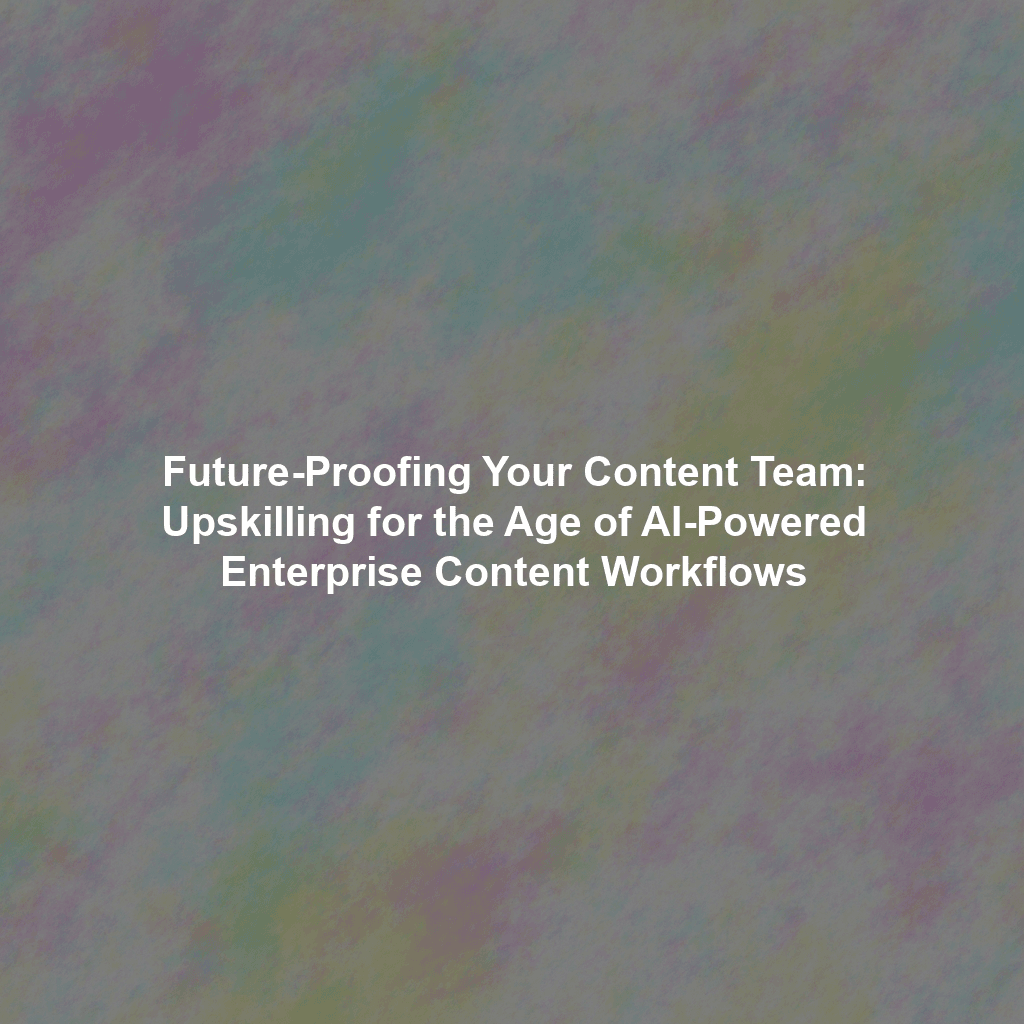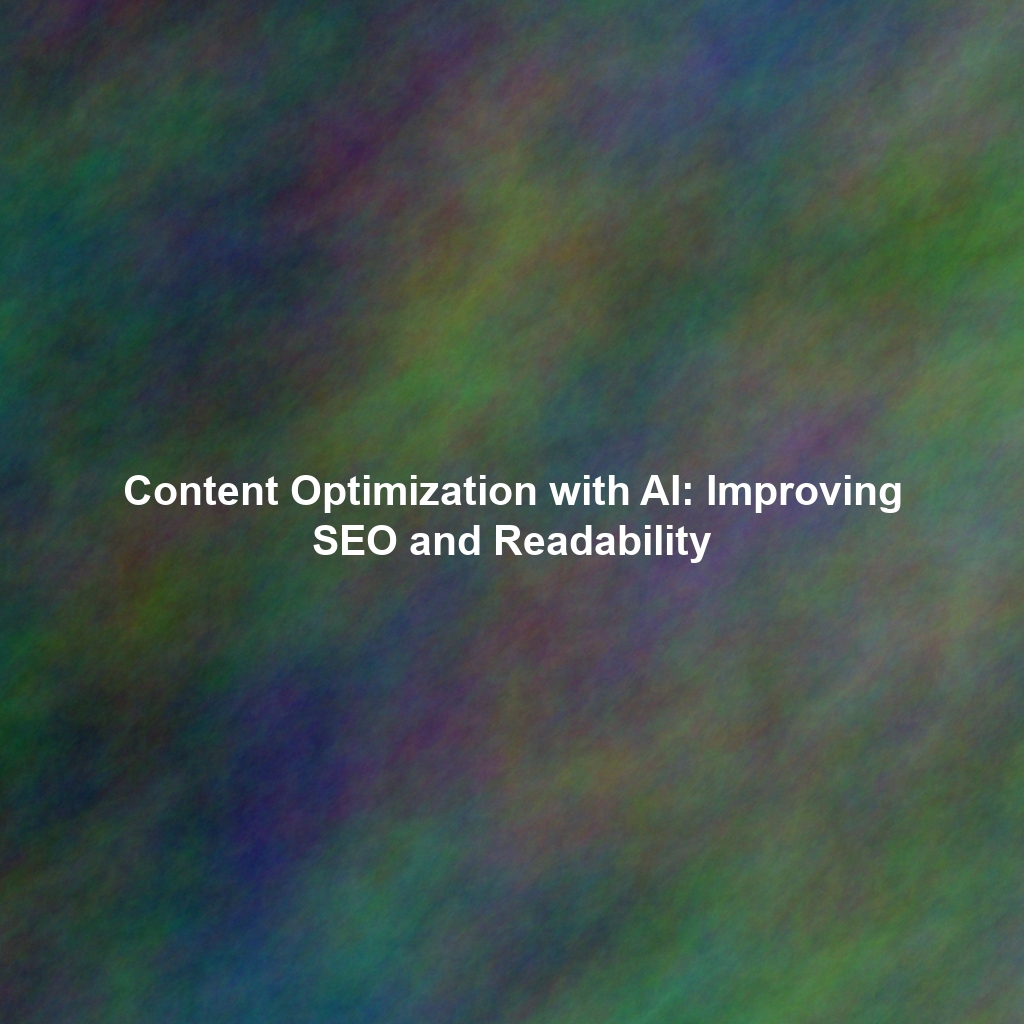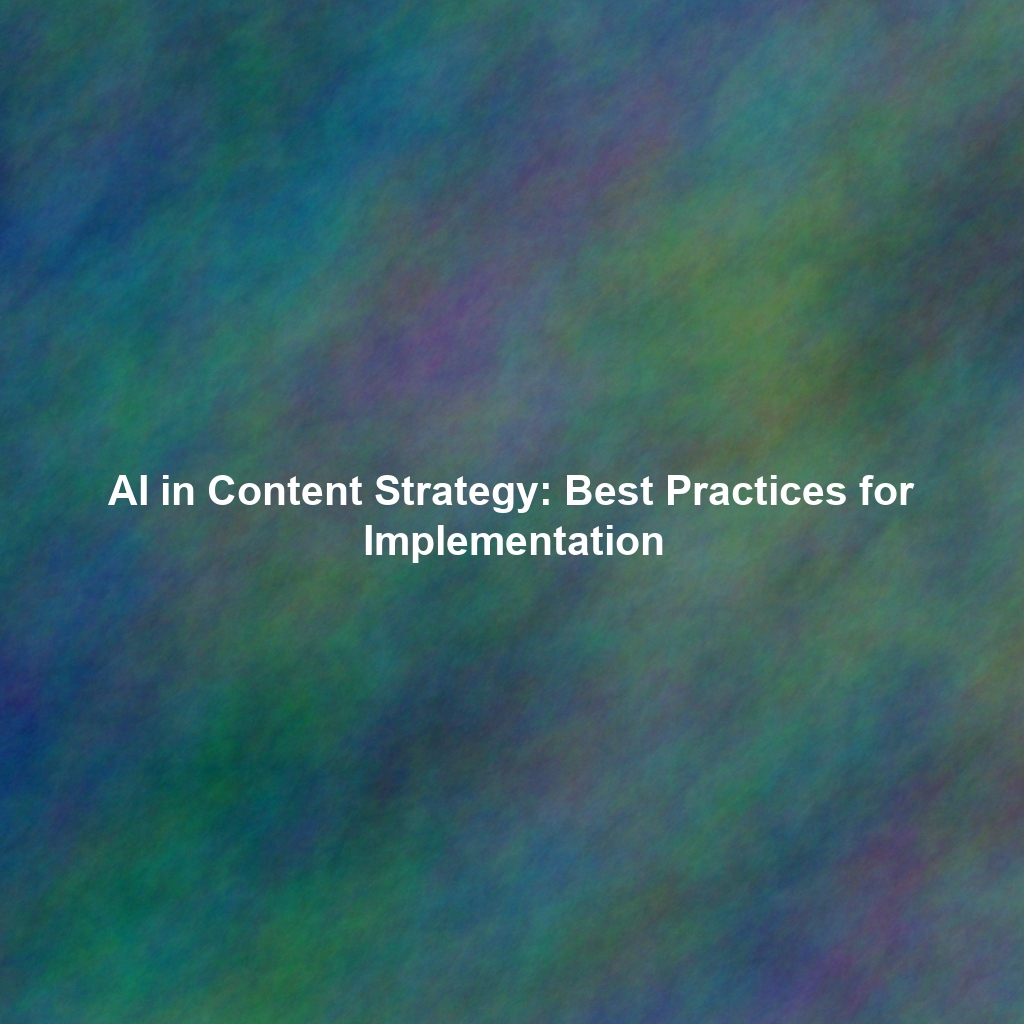The traditional content lifecycle, often characterized by manual ideation, laborious drafting, and reactive optimization, is being systematically re-engineered by AI. This isn’t about replacing human ingenuity; it’s about augmenting it, enabling content teams to operate with unprecedented scale, precision, and analytical depth. The strategic integration of AI allows for the automation of repetitive, low-value tasks, thereby liberating human capital to focus on higher-order functions: strategic thinking, creative differentiation, and the nuanced understanding of audience psychology. The objective is to move beyond mere content production to intelligent content orchestration, where every piece of content is a calculated investment designed to yield maximum impact and measurable returns. This requires a fundamental shift in the skillset of content professionals, moving them from mere creators to strategic architects of AI-powered content ecosystems.
The AI Revolution: Reshaping Enterprise Content Workflows with Precision
AI is no longer a theoretical construct or a mere buzzword; it is a tangible, operational force systematically reshaping how enterprises conceptualize, produce, manage, and deliver content. Its integration is permeating every stage of the content lifecycle, driving efficiencies and unlocking capabilities previously unattainable. This revolution is characterized by AI’s capacity to process vast datasets, identify complex patterns, and generate outputs at a scale and speed that human teams alone cannot match. The impact is profound across several key areas:
- Ideation & Research: AI’s analytical prowess can sift through colossal datasets—including search trends, social media conversations, competitor content performance, and academic research—to identify nascent topics, emerging audience needs, and untapped content gaps. Tools powered by AI can analyze sentiment, predict content virality, and even suggest novel angles for existing topics. This moves ideation from intuitive brainstorming to data-driven foresight, ensuring content relevance from its inception. For instance, AI can identify a sudden surge in queries around “sustainable supply chain logistics” and suggest comprehensive content pillars to address this emerging interest.
- Content Creation & Augmentation: This is perhaps the most visible application of AI. AI writing assistants can generate initial drafts, summarize lengthy documents, rephrase existing content for different platforms, and even create diverse content formats like social media posts, email snippets, or video scripts. Beyond generating new content, AI can optimize existing content for SEO, readability, and brand voice, ensuring consistency and adherence to best practices at scale. Platforms like Content Hurricane exemplify this, offering AI specifically trained to produce expert-level, E-E-A-T compliant blog content that can outperform human-only efforts in terms of inbound lead generation.
- Content Optimization & Personalization: Post-creation, AI algorithms analyze content performance in real-time, identifying areas for improvement based on engagement metrics, conversion rates, and user behavior. AI can dynamically personalize content delivery, tailoring recommendations, calls to action, and even visual elements to individual user preferences. This hyper-personalization enhances user experience and significantly boosts conversion rates, moving from one-to-many broadcasting to one-to-one engagement at scale.
- Content Distribution & Amplification: AI can automate content scheduling, suggest optimal publishing times based on audience activity patterns, and recommend the most effective distribution channels for specific content types. Furthermore, AI-powered tools can analyze social media trends to identify opportune moments for content amplification, predict which content will resonate most with specific audience segments, and even personalize content experiences across diverse platforms, ensuring maximum reach and impact.
While AI offers immense potential for efficiency and effectiveness, it is critical to understand that it does not, and cannot, replace the need for skilled content professionals. Instead, it fundamentally redefines their role, demanding a new skillset focused on strategic collaboration, critical oversight, and the nuanced application of intelligent systems. The human element shifts from rote production to strategic direction and quality assurance, ensuring that AI-generated content is not just voluminous but also valuable, authentic, and aligned with core business objectives.
Essential Skills for the AI-Driven Content Professional: A New Intellectual Imperative
To navigate the AI-powered content landscape successfully, content professionals must cultivate a sophisticated blend of technical acumen and refined soft skills. This is an intellectual challenge, requiring a high IQ approach to problem-solving and a commitment to continuous learning. Here are some of the most crucial competencies:
1. AI Literacy and Tool Proficiency: Understanding the Engine
A superficial understanding of AI is insufficient. Content professionals need to develop a foundational AI literacy, grasping the core concepts behind different AI models (e.g., generative AI, discriminative AI, machine learning, natural language processing). This includes understanding their capabilities, their inherent limitations, and their ethical implications. Proficiency extends to knowing how to effectively operate and integrate AI-powered tools such as writing assistants (e.g., Content Hurricane, Jasper.ai, Copy.ai), SEO optimization platforms (e.g., Surfer SEO, Semrush, Ahrefs), content analytics dashboards, and content management systems with AI integrations. It’s not about becoming an AI engineer, but about understanding the operational mechanics of these tools to maximize their utility and troubleshoot effectively.
Actionable Tip: Dedicate structured time each week—perhaps 2-3 hours—to hands-on experimentation with various AI tools. Explore their advanced features, test their outputs against specific criteria, and document their strengths, weaknesses, and optimal use cases. Consider starting with free trials or freemium versions to gain practical experience without immediate financial commitment. Engage with user communities for these tools to learn best practices and common pitfalls.
2. Prompt Engineering and Content Briefing: The Art of Instruction
The quality of AI-generated content is directly proportional to the quality of the instructions it receives. Mastering the art of prompt engineering—crafting clear, specific, nuanced, and context-rich instructions for AI models—is a paramount skill. This is a new form of content “coding,” where precision in language yields precise outputs. It requires understanding how AI models interpret prompts, how to guide their creative direction, and how to iterate on prompts to refine outputs. This skill is inextricably linked to strong content briefing capabilities, ensuring that AI tools comprehensively understand the target audience, the desired brand voice, the specific content objectives, and the intended outcomes. A well-engineered prompt is the difference between generic output and highly targeted, valuable content.
Actionable Tip: Practice writing detailed content briefs that meticulously outline key objectives, granular target audience demographics and psychographics, desired tone and style (with examples), specific keywords (primary and secondary), required content length, and any non-negotiable brand guidelines. Systematically experiment with different prompt variations for the same content piece, observing how subtle changes in wording, structure, or added context impact the AI’s output. Maintain a log of successful prompts and their corresponding outputs to build a personal library of effective instructions.
3. Critical Thinking and Editorial Oversight: The Human Filter
Crucially, AI-generated content is not a substitute for human judgment; it is a foundation upon which human intelligence builds. Content professionals must possess acute critical thinking and robust editorial oversight skills to evaluate AI outputs rigorously. This includes meticulous fact-checking, ensuring absolute accuracy and originality, and verifying brand consistency. The ability to identify subtle inaccuracies, logical inconsistencies, or deviations from brand voice is paramount. This demands strong proofreading, copyediting, and rewriting capabilities to refine AI-generated content, infusing it with the necessary nuance, authenticity, and human touch to meet exacting quality standards. The human editor acts as the ultimate quality gatekeeper, ensuring E-E-A-T compliance and brand integrity.
Actionable Tip: Develop a comprehensive, multi-point checklist for evaluating all AI-generated content before publication. This checklist should include criteria such as factual accuracy (cross-referencing with authoritative sources), clarity, adherence to brand tone and style, originality (using plagiarism checkers), grammatical correctness, and overall alignment with content objectives. Always conduct a thorough human review and edit of AI outputs, treating them as sophisticated first drafts rather than final products. Consider implementing a peer review process for AI-generated content to catch errors and inconsistencies.
4. Data Analysis and Performance Measurement: The ROI Imperative
AI tools, by their nature, generate vast quantities of performance data. Content professionals must be adept at analyzing this data to extract actionable insights, measure the effectiveness of content strategies, and make data-driven decisions that maximize ROI. This requires a strong understanding of key metrics—beyond vanity metrics—such as engagement rates, reach, conversion rates, time on page, bounce rate, and lead quality. The ability to interpret complex data, identify trends, and translate findings into strategic adjustments for future content creation is indispensable. This directly links content efforts to quantifiable business outcomes, a core tenet of effective management.
Actionable Tip: Immerse yourself in content analytics platforms such as Google Analytics, Adobe Analytics, and the native analytics dashboards of social media platforms (e.g., LinkedIn Page Analytics, Facebook Insights). Learn how to create custom reports, segment data, and identify correlations between content attributes and performance metrics. Practice presenting data-driven insights to stakeholders, focusing on the “so what” and the actionable implications for content strategy. Consider online courses or certifications in web analytics to deepen your expertise.
5. Adaptability and Continuous Learning: Navigating the Frontier
The field of AI is characterized by relentless innovation and rapid evolution. For content professionals, this necessitates an unwavering commitment to adaptability and continuous learning. Staying abreast of the latest AI trends, experimenting with new tools and techniques, and proactively seeking out training opportunities are not optional but essential. This involves cultivating a growth mindset, embracing change, and viewing new technologies as opportunities for enhancement rather than threats. The ability to quickly learn, unlearn, and relearn will be a defining characteristic of successful content professionals in the AI era.
Actionable Tip: Implement a personal learning strategy. Subscribe to leading industry newsletters (e.g., from Gartner, Forrester, reputable AI research labs), follow prominent AI experts and thought leaders on platforms like LinkedIn and X (formerly Twitter), and make it a habit to attend relevant webinars, virtual conferences, and industry meetups. Dedicate a portion of your professional development budget to formal courses or certifications in emerging AI applications for content and marketing. Read academic papers or summaries of research from institutions like Princeton University’s Computer Science Department or Carnegie Mellon University’s School of Computer Science to understand foundational advancements.
6. Collaboration and Communication: Orchestrating the Ecosystem
Successfully integrating AI into enterprise content workflows demands seamless collaboration and crystal-clear communication across interdisciplinary teams. Content professionals must be adept at communicating their needs and expectations to technical teams (e.g., AI developers, data scientists), providing constructive feedback on AI tool development, and working collaboratively with marketing, sales, and product teams to optimize content performance across the entire customer journey. This requires strong interpersonal skills, the ability to translate complex technical concepts into business language, and a proactive approach to fostering cross-functional synergy. The content team becomes a central hub, orchestrating the AI-powered content ecosystem.
Actionable Tip: Actively participate in cross-functional meetings that discuss AI integration strategies, content automation, and data utilization. Take the initiative to schedule regular check-ins with technical teams to provide user feedback on AI tool functionality and suggest improvements. Practice articulating your content needs in a structured, measurable way that technical teams can translate into AI model enhancements. Develop internal documentation or best practices for AI tool usage to facilitate knowledge sharing within your content team.
Training Programs and Skill Development Resources: Investing in Human Capital
The imperative for upskilling is clear, and fortunately, a wealth of resources exists to empower content professionals in the age of AI. Organizations and individuals should strategically invest in these development pathways:
- Online Courses and Specializations: Platforms like Coursera, Udemy, edX, and LinkedIn Learning offer extensive curricula on AI fundamentals, machine learning for marketers, prompt engineering, advanced content marketing strategies, and data analysis. Look for specializations that combine theoretical knowledge with practical application. Many top universities also offer online courses through these platforms.
- Industry Certifications: Pursue certifications from reputable bodies in areas such as SEO (e.g., Google’s certifications), content marketing (e.g., HubSpot Academy), digital analytics, or specific AI tool proficiencies. These certifications validate expertise and demonstrate a commitment to professional development.
- AI Tool-Specific Training: Most leading AI tool providers (including Content Hurricane, Jasper.ai, Copy.ai, Surfer SEO, Semrush) offer comprehensive training resources, tutorials, webinars, and knowledge bases designed to help users master their products effectively. Leverage these vendor-specific resources for hands-on operational proficiency.
- Mentorship Programs: Seek out mentorship from experienced content professionals who are already successfully integrating AI into their workflows. Learning from those who have navigated the initial challenges can accelerate your own development and provide invaluable practical insights.
- Internal Training Initiatives: Advocate for and participate in internal training programs within your organization. These can be tailored to your company’s specific AI tools and workflows, fostering a collective uplift in AI literacy and collaborative best practices across the entire content team. Consider inviting external experts for workshops.
- Industry Conferences and Workshops: Attend leading digital marketing, AI, and content strategy conferences (e.g., Content Marketing World, Marketing AI Conference, SXSW Interactive). These events offer exposure to cutting-edge trends, networking opportunities, and practical workshops on AI applications.
- Academic Resources: For those with a deeper interest in the underlying science, exploring open-access courses or research papers from university computer science departments (e.g., MIT OpenCourseWare, Stanford AI Lab) can provide a robust theoretical foundation.
Strategies for Adapting to the Changing Content Landscape: A Proactive Approach
Adapting to the AI-powered content landscape requires more than just acquiring new skills; it demands a proactive, strategic, and culturally supportive approach within the organization:
- Embrace Experimentation and Iteration: Do not shy away from experimenting with new AI tools, techniques, and workflows. Start with small, manageable pilot projects to test hypotheses, gather data, and demonstrate value. Gradually scale up successful experiments. This iterative approach minimizes risk and fosters a culture of innovation.
- Focus on Value-Added Activities: Strategically delegate routine, repetitive, and high-volume content generation tasks to AI. This frees up human content professionals to focus on higher-value activities that demand unique human attributes: strategic planning, creative ideation, brand storytelling, nuanced audience engagement, complex problem-solving, and critical editorial oversight. This is where human creativity and high IQ truly shine.
- Develop a Comprehensive Content AI Strategy: Create a clear, documented roadmap for integrating AI into your content workflows. This strategy should outline specific goals (e.g., “increase blog post output by 50% while maintaining E-E-A-T standards”), timelines, assigned responsibilities, and key performance indicators for AI-driven content. This ensures a coherent and measurable approach.
- Foster a Culture of Continuous Learning and Collaboration: Encourage an organizational culture that champions continuous learning, knowledge sharing, and cross-functional collaboration. Create forums where content team members can share their experiences with AI tools, discuss challenges, and collectively develop best practices. A supportive environment is crucial for successful technological adoption.
- Re-evaluate and Redefine Roles: Proactively redefine job roles and responsibilities within the content team to reflect the new AI-augmented reality. This might involve creating new roles like “Prompt Engineer,” “AI Content Strategist,” or “Content Quality Assurance Specialist” who focus on overseeing AI outputs. Clearly communicate these evolving roles to the team.
- Prioritize Ethical AI Use: Establish clear guidelines and protocols for the ethical use of AI in content creation. This includes ensuring transparency, avoiding bias, protecting data privacy, and maintaining journalistic integrity. Adherence to ethical principles is crucial for building and maintaining audience trust.
Conclusion: The Intelligent Future of Content and the Thriving Professional
The profound rise of AI-powered enterprise content workflows presents content professionals not with a threat, but with an unparalleled opportunity. By proactively embracing upskilling, meticulously developing essential AI-centric competencies, and adopting a strategic, data-driven approach, content teams can not only future-proof themselves but also position their organizations for unprecedented success in this rapidly evolving digital landscape. The imperative is not to fear AI, but to strategically embrace it as a powerful, intelligent tool that can profoundly augment human creativity, dramatically enhance efficiency, and ultimately drive superior content outcomes and a compelling return on investment. The future of content is intelligent, collaborative, and those who adapt with foresight and intellectual rigor will undoubtedly thrive, leading their organizations to new heights of digital dominance.
#AIContentStrategy #Upskilling #EnterpriseContent #AIinMarketing #ContentWorkflows #FutureOfWork #DigitalTransformation #PromptEngineering #DataDrivenContent #ContentROI
 Skip to content
Skip to content

